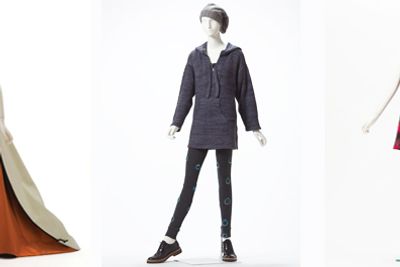By Laura Latzko, Nov. 20, 2014.
For American designers who choose to operate within the United States, manufacturing has its own set of challenges, moral issues and processes.
“Fashioned in America,” an exhibition at the Phoenix Art Museum through March 15, is presented in tandem with director James Belzer’s related film, Make It In America: Empowering Global Fashion.
Together the exhibit and the film explore how the U.S. manufacturing industry drives and influences established and emerging designers, including openly gay designer Ralph Rucci.
Alligator leather on silk tulle, duchess silk satin. Gift of Chado Ralph Rucci in honor of the Museum’s 50th Anniversary.
Photos by Ken Howie.
The New York-based designer has produced his brand of luxurious, artistic, architectural and minimalist women’s fashions for more than two decades under the label Chado Ralph Rucci.
Dennita Sewell, Phoenix Art Museum’s curator of fashion design, said a number of the designers, including Rucci, Wes Gordon, Nanette Lepore, Anna Sui and Yeohlee Teng, appear in both the film and exhibition.
The film and exhibit explore the dynamics of the U.S. manufacturing industry, including incubator programs that help designers to get established, the role of factories that produce U.S.-made designs and the collaborative process of American-based designers and manufacturers.
For the duration of the “Fashioned in America” exhibit, a shortened version of Belzer’s film will be showing on a loop, and the museum will screen the full version Jan. 2.
Initially the focus of Belzer’s documentary was on the garment districts, but he found that factories and designers in other parts of the country, including Los Angeles and Miami, faced similar challenges with operating in the U.S.
Through this project, Belzer said he hopes to raise consciousness and gain support for local manufacturing by providing a behind-the-scenes look at the work that goes on in factories that support and sustain the American fashion industry.
“A lot of people don’t think about what they buy or where it is made, so the whole goal was to explain that there’s an economy and people’s livelihood connected to these factories,” Belzer said. “That’s the core mission of the film, to show the factories up and running and the people who work there.”
Belzer added that he isn’t trying to discourage global manufacturing, but instead he wants to help facilitate interest in related careers and foster growth of the U.S. manufacturing industry.
Similarly, “Fashioned in America” takes a closer look at the history of the American-based fashion industry.
“The show will address the history of manufacturing in the U.S. and how and why it has changed and why it is important to fashion designers,” Sewell said. “It also addresses the importance of the fashion design industry, not just to cities like New York but to the whole country.”
In the 1960s, around 95 percent of clothing in the U.S. was made in the New York Garment Center. Today, only around 3 percent of the country’s clothing comes from the area. Sewell added that the film and exhibition raise questions about how and why designers produce in the U.S. today.
“I’m hoping people will leave the gallery with a raised consciousness of the considerations that go into making clothing, and the vast support system that is needed to produce garments,” Sewell said.
In coordinating the exhibition, Sewell worked closely with designers to obtain pieces reflecting their individual styles and diversity. As a result, the museum features more than 40 ensembles and accessories from well-known and emerging designers from different parts of the U.S., including The Elder Statesman founder Greg Chait, an LA-based designer originally from Phoenix.
“We have tremendous talent and creativity in the U.S., and I wanted to show the different points of view and the strength of our designing and manufacturing capabilities,” Sewell said.
For the duration of the exhibition, the museum will run special programming, including a visit from The Elder Statesman designer Greg Chait Dec. 13 and the “Made in America” symposium Jan. 17.
“Fashioned in America”
Through March 15
Phoenix Art Museum
1625 N. Central Ave., Phoenix
Admission: Adults, $15; seniors, $12, students with ID, $10; children 6-17, $6; children under 5 and museum members, free.
602-257-1880
